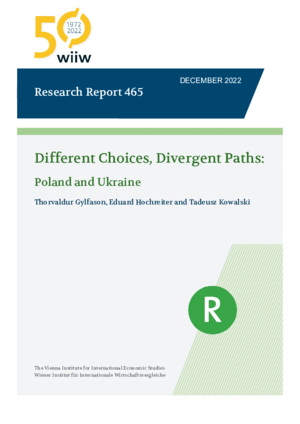Different Choices, Divergent Paths: Poland and Ukraine
Thorvaldur Gylfason, Eduard Hochreiter and Tadeusz Kowalski
wiiw Research Report No. 465, December 2022
37 pages including 3 Tables and 16 Figures
We compare the economic growth trajectories of Poland and Ukraine since 1990 to try to understand the extent to which the observed growth differentials can be traced to increased efficiency in the use of capital and other factors (intensive growth), rather than to simple accumulation of capital (extensive growth). We stress the role of qualitative factors such as education, governance and institutions. We ask whether the EU perspective and NATO membership played a role. We discuss the closely related histories of the two countries and note the stark differences between them, including their different approaches to the EU vs Russia, full vs incomplete transition to a market economy, and democracy vs anocracy, as well as different initial conditions. We compare key determinants of growth and growth trajectories, using economic as well as social indicators, and trying to disentangle efficiency and accumulation and combine path dependence and the role and scope of creative destruction. While Poland had the shortest and mildest transformation recession among CEE countries, Ukraine has been stagnant, or in decline, since 1990. The statistics we report and the stories we tell suggest that both countries have a complex relationship with democracy and that the nearly threefold difference in per capita GDP at PPP in 2021 in Poland’s favour, with the ratio of investment to GDP similar in both countries, can most plausibly be traced to: (a) Poland’s more extensive and diversified exports, and fewer restrictions on trade, in addition to more comprehensive and quicker restructuring of the national economy inspired by the EU perspective; (b) Poland’s more extensive and better-quality education; (c) Poland’s greater democracy and longer experience of democracy, lower levels of corruption, better governance, and freer press; (d) Poland’s smaller agricultural sector and greater emphasis on manufacturing; and (e) Poland’s lower inflation and higher level of financial development. Furthermore, Poland built market-friendly institutions to EU specifications and joined NATO. Against all this, Ukraine had more economic equality and lower unemployment as well as, from the early 1990s, a lower initial level of income per person, but was hampered by political divisions, path-dependent corruption and poor governance. During the global Covid-19 pandemic, Ukraine apparently suffered fewer deaths than Poland, despite fewer vaccinations.
Reference to wiiw databases: wiiw Annual Database, wiiw Monthly Database, wiiw FDI Database
Keywords: Economic growth, Poland, Ukraine, Governance, Transition, Education, Economic reforms, Exports, European Union, Inflation, Labour markets
JEL classification: O11, O16, O19
Countries covered: Austria, Belarus, Croatia, Estonia, Georgia, Germany, Hungary, Latvia, Lithuania, Poland, Russia, Ukraine, Prussia
Research Areas: Macroeconomic Analysis and Policy, Labour, Migration and Income Distribution, International Trade, Competitiveness and FDI
